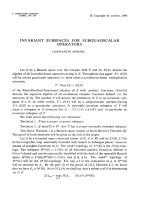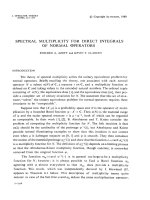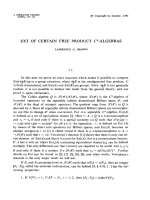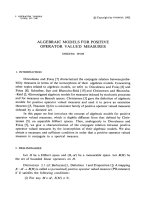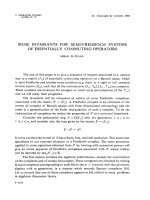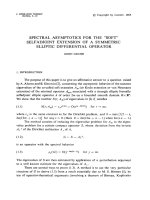Báo cáo toán học: "Enumerative Formulae for Unrooted Planar Maps: a Pattern" ppt
Bạn đang xem bản rút gọn của tài liệu. Xem và tải ngay bản đầy đủ của tài liệu tại đây (141.67 KB, 14 trang )
Enumerative Formulae for Unrooted Planar Maps:
a Pattern
Valery A. Liskovets
∗
Institute of Mathematics
National Academy of Sciences, 220072, Minsk, BELARUS
Submitted: Feb 5, 2004; Accepted: Nov 2, 2004; Published: Dec 7, 2004
Mathematics Subject Classifications: 05C30, 05A10
Abstract
We present uniformly available simple enumerative formulae for unrooted pla-
nar n-edge maps (counted up to orientation-preserving isomorphism) of numerous
classes including arbitrary, loopless, non-separable, eulerian maps and plane trees.
All the formulae conform to a certain pattern with respect to the terms of the sum
over t | n, t < n. Namely, these terms, which correspond to non-trivial automor-
phisms of the maps, prove to be of the form φ
n
t
αr
t
kt
t
,where φ(m)istheEuler
function, k and r are integer constants and α is a constant or takes only two ratio-
nal values. On the contrary, the main, “rooted” summand corresponding to t = n
contains an additional factor which is a rational function of n.Twosimplenew
enumerative results are deduced for bicolored eulerian maps. A collateral aim is to
briefly survey recent and old results of unrooted planar map enumeration.
1 Introduction
We discover and discuss an unexpected pattern of the formulae for counting non-isomor-
phic unrooted planar maps derived previously in [10, 12, 15, 16, 17, 18]: the cancellation
of a rational factor in the summands over the divisors t | n, t < n. Formerly we have not
considered these formulae in such an explicit form (rather, we expressed them reductively,
that is, in terms of the number of the corresponding rooted maps), nor did we compare
them with each other. Two most striking instances of such behaviour have appeared only
recently [17, 18]. The same pattern is also valid for several enumerative formulae derived
by other researchers, see [3, 6]. More than ten results confirming it are considered. Almost
all the results are based on the general method of the enumeration of unrooted planar
maps developed in [10, 12], and two simple new results are deduced in the present paper.
∗
Supported by INTAS and SCST of the Republic of Belarus under grant 03-50-5975.
the electronic journal of combinatorics 11 (2004), #R88 1
In this article, a map means a planar map: a proper embedding of a finite connected
planar graph (generally with loops and multiple edges) in the (oriented) sphere. A map is
called rooted if an edge-end (a vertex-edge incidence pair), called its root, is distinguished
in it. The corresponding edge and vertex are said to be rooted. Unlike maps without a
distinguished edge-end (called unrooted), rooted maps have only the trivial automorphism.
1.1 Formulation
So far, in counting unrooted maps up to orientation-preserving isomorphism we consi-
dered mainly classes of planar maps M for which the corresponding numbers of rooted
n-edge maps M
(n) are expressed by simple sum-free formulae. In almost all the cases,
the latter can be represented in the form
M
(n)=
q(n)
p(n)
r
n
kn
n
, (1)
where k and r are some positive integers and p(n)andq(n) are some polynomials with
integer coefficients.
Our formulae for the number of unrooted maps M
+
(n) of the same classes follow a
certain pattern. In particular, they contain one summation over the divisors of n, which
correspond to non-trivial automorphisms of the maps. Moreover, as we will see below
(and what is the subject of the present consideration), all these sums can be represented
uniformly as follows:
t<n, t|n
φ
n
t
αr
t
kt
t
, (2)
where φ(m) is the Euler totient function, r and k are the same as in (1) and α is a constant
or α = α(t) is a simple bounded “rational-factor-free” function of t. In other words, in
the summands (with t = n), the rational factor
q(t)
p(t)
disappears completely. In all cases
under consideration, α proves to be a constant or, in three related cases, it takes only two
rational values.
Sometimes we consider the pattern (2) with respect to maps having mn edges, where
m is a constant different from 1.
The formulae usually contain one or several additional summands depending on the
parity of n; their presence does not change the pattern.
1.2 An interpretation
The enumerative formulae for the majority of classes M of unrooted maps considered
below have been known to be inexplicably much simpler than we could expect in the
framework of the enumerative method used to obtain these formulae [10, 12]: the inter-
mediate sums of the terms corresponding to the classes of quotient maps with respect to
rotational automorphisms of order n/t, t | n, t < n, arising from this method disappear
the electronic journal of combinatorics 11 (2004), #R88 2
ultimately as if these quotient maps formed the same, or almost the same, sets M(t). In
general, this is not the case: for instance, quotient maps of non-separable maps are not
necessarily non-separable, and quotient maps of loopless maps may contain loops. The
pattern discussed in the present note, possibly unimportant by itself, manifests a supple-
mentary unexpected regularity: the average number of admissible choices of the rotation
axes in the t-edge quotient maps so as to lift them back into M(n) (the key step of the
enumerative method) coincides with (or is proportional to) the inverse fraction
p(t)
q(t)
. This
coincidence is unexplained even for the simple class A(n) of arbitrary maps (see Sect. 2.5),
where for t<n/2, the quotient maps are also arbitrary t-edge maps (rotations of order
2 bring slight complications; they contribute only to one term, which is immaterial in
the context of the present paper). What is the nature of this phenomenon, or is it not
merely an artefact? This question remains open; hardly an explanation can be obtained
in the framework of the considered enumerative method of quotient maps. We will dis-
cuss briefly possible generalizations and limitations of the patterns (1) and (2) in the last
section.
2 Counting unrooted maps
Additional definitions and details concerning the results stated below and their proofs can
be found in the corresponding references.
2.1 Loopless maps L
According to [30], for rooted loopless maps,
L
(n)=
2(4n +1)!
(n + 1)!(3n +2)!
=
2(4n +1)
(n + 1)(3n + 1)(3n +2)
4n
n
. (3)
Just the inverse fraction
p(t)
q(t)
=
(t + 1)(3t + 1)(3t +2)
2(4t +1)
multiplied by L
(t) for t<nap-
pears in the main formula [18, Th.1], which results in the following expression for the
number of unrooted loopless maps:
L
+
(n)=
1
2n
2(4n +1)
(n + 1)(3n + 1)(3n +2)
4n
n
+
t<n, t|n
φ
n
t
4t
t
+
2n
n +1
2n
n−1
2
if n is odd
2n
n−2
2
if n is even
.
(4)
Thus, we have the pattern (2) with k =4andα = r =1. This is the instance with the
most non-trivial polynomials p(n)andq(n) (of degrees 3 and 1 respectively).
the electronic journal of combinatorics 11 (2004), #R88 3
2.2 Non-separable maps B
In another terminology, these are 2-connected maps. For these maps by [26],
B
(n)=
2(3n − 3)!
n!(2n − 1)!
=
4
3(3n − 2)(3n − 1)
3n
n
. (5)
Thus, p(n)=3(3n −2)(3n − 1). Now, the sum in the main formula of [15] for the number
of unrooted non-separable maps B
+
(n) contains terms with the factor
1+9
t
2
=
(3t − 2)(3t − 1)
2
,t<n. (6)
It is just p(t) up to multiplicative constant; therefore this result can be represented in the
following form:
B
+
(n)=
1
2n
4
3(3n − 2)(3n − 1)
3n
n
+
2
3
t<n, t|n
φ
n
t
3t
t
+
4(n +1)
3(3n − 1)(3n +1)
3
n+1
2
n+1
2
if n is odd
1
3(3n − 2)
3
n
2
n
2
if n is even
.
(7)
Thus, the summands here are of the form (2) with k =3,r=1andα =2/3.
2.3 Eulerian maps E
These are maps with all vertices of even valency. By [26] and [20] (see also [28]),
E
(n)=
3 · 2
n−1
(2n)!
n!(n +2)!
=
3 · 2
n
2(n +1)(n +2)
2n
n
. (8)
According to [17],
E
+
(n)=
1
2n
3 · 2
n
2(n +1)(n +2)
2n
n
+3
t<n, t|n
φ
n
t
2
t−2
2t
t
+
2
(n−1)/2
n +1
n − 1
n−1
2
if n is odd
1
n
t|
n
2
φ
n
t
2
t−3
2t
t
+
2
(n−4)/2
n +2
n
n
2
if n is even
.
(9)
Thus, the denominator (t +1)(t + 2) has disappeared, and we recognize (taking into
account both sums over t) the pattern (2) with k = r =2,α =3/4 for odd n and
α =
1ift |
n
2
3/4 otherwise
for even n.
We note that, by duality, E
+
(n) is also the number of bipartite maps.
the electronic journal of combinatorics 11 (2004), #R88 4
2.4 Unicursal maps U
These are maps with exactly two odd-valent vertices. By [17],
U
(n)=2
n−2
2n
n
(10)
and
U
+
(n)=
1
2n
t|n
n/t odd
φ
n
t
2
t−2
2t
t
+
2
(n−3)/2
n − 1
n−1
2
if n is odd
2
(n−6)/2
n
n
2
if n is even
. (11)
Thus, with no cancellation (in this degenerate case, t = n is not an exception), this
formula meets the pattern (2) with k = r =2andα =1/4ifn/t is odd and α =0
otherwise.
2.5 Arbitrary maps A
According to [26],
A
(n)=
2(2n)!3
n
n!(n +2)!
=
2 · 3
n
(n +1)(n +2)
2n
n
. (12)
By Euler’s formula, a map with t edges has t + 2 vertices and faces altogether. Thus we
can choose two axial cells among them in
t+2
2
ways. This is just the denominator in
the right-hand side of formula (12) for A
(t). Therefore this fraction disappears in the
t-summands of the formula for the number of unrooted maps A
+
(n) [10, 11, 12]:
A
+
(n)=
1
2n
2 · 3
n
(n +1)(n +2)
2n
n
+
t<n, t|n
φ
n
t
3
t
2t
t
+
2 · 3
(n−1)/2
n +1
n − 1
n−1
2
if n is odd
2(n − 1)3
(n−2)/2
n(n +2)
n − 2
n−2
2
if n is even
.
(13)
Thus, we get the pattern (2) with k =2,r=3andα =1.
2.6 Plane trees T
It is well known (one of diverse interpretations of the Catalan numbers) that
T
(n)=
(2n)!
n!(n +1)!
=
1
n +1
2n
n
. (14)
the electronic journal of combinatorics 11 (2004), #R88 5
Now, for unrooted plane trees by [27] (cf. also [12]),
T
+
(n)=
1
2n
1
n +1
2n
n
+
t<n, t|n
φ
n
t
2t
t
+
n
n−1
2
if n is odd
0ifn is even
.
(15)
Thus, the terms are of the form (2) with k =2andα = r =1.
Formulae (14) and (15) have numerous generalizations. Consider one of them
1
, coun-
ting plane m-gonal cacti (or Husimi trees), m ≥ 2. If an m-gonal cactus consists of n
m-gons, then it contains N = mn edges and v =(m − 1)n + 1 vertices; however for
m = 2 we replace all 2-gons (that is, pairs of parallel edges) by single edges and obtain
an ordinary plane tree with N = n edges. Now for the number T
m
(n)ofrootedplane
m-gonal cacti with nm-gons we have, according to [3],
T
m
(n)=
1
(m − 1)n +1
mn
n
. (14
)
For unrooted m-gonal cacti, formula (88) [3] can be represented as follows:
T
+
m
(n)=
1
mn
1
(m−1)n+1
mn
n
+
t<n, t|n
φ
n
t
mt
t
+
s|(m,n−1)
s>1
φ(s)
mn
s
n−1
s
, (15
)
where (m, n − 1) denotes the greatest common divisor. For a fixed m, the last sum is
inessential in our context, and we see the behaviour of the form (2) (the first sum) with
k = m and α = r =1. Formula (14
) conforms to (1) as well. This time, however, both
patterns are considered with respect to the number of polygonal blocks n, which differs
(for m>2) from the number of edges N.
Formulae (14
)and(15
) for m = 3 also counts so-called 2-trees (resp., rooted and
unrooted) with n triangles [5].
2.7 Constellations C
m
In terms of maps, m-constellations (or simply constellations) are maps in which the faces
are properly bicolored black and white, all black faces are of size m and the sizes of all
white faces are multiples of m. All vertices of an m-constellation can be (and are considered
to be) colored with the colors 1, 2, ,min a unique way so that the vertices around each
black face are colored with 1, 2, ,m in counterclockwise order and, moreover, the root
vertex is colored with 1 and the other end of the root edge is colored with 2. An m-
constellation with n black faces has N = mn edges. According to [6], the number of such
rooted m-constellations is
C
m
(n)=
(m +1)m
n
m((m − 1)n + 1)((m − 1)n +2)
mn
n
(16)
1
Our bibliography is incomplete for counting unrooted plane trees and tree-like maps.
the electronic journal of combinatorics 11 (2004), #R88 6
and the number of unrooted m-constellations with n black faces is
C
+
m
(n)=
1
mn
(m +1)m
n
((m − 1)n + 1)((m − 1)n +2)
mn
n
+
m +1
2
t<n, t|n
φ
n
t
m
t
mt
t
(17)
provided that the symmetries have to preserve the colors of the faces and vertices. Now,
with respect to the number of black faces, (17) is an instance of the pattern (2) with
r = m and α =
m+1
2
.
We note that m-constellations for m = 2 in fact coincide with bipartite maps in which
the vertices are properly bicolored. More exactly, any 2-constellation becomes a bipartite
map after transforming every black digon into an edge, and vice versa. The point is that
the planar bipartite maps are just the maps with faces of even sizes, and like are the white
faces of 2-constellations. These arguments explain why formula (16) for m = 2 coincides
with (8). However (17) differs from (9) because of additional restrictions imposed on
the symmetries of m-constellations. Their difference can be interpreted combinatorially.
Specifically,
E
+
(n)=2E
+
(n) − C
+
2
(n) (18)
enumerates unrooted vertex-bicolored bipartite maps which are self-dual with respect to
reversing the colors. Indeed, the vertices of a bipartite map can be colored properly with
black and white in two different ways unless it is self-dual in this sense, in which case
only one coloring arises up to isomorphism. Equivalently (by vertex-face duality), this is
the number of n-edge face-bicolored eulerian maps self-dual with respect to reversing the
colors.
By comparing formulae (9) and (17) we conclude from (18) that
E
+
(n)istwicethe
second term of the right-hand side expression in (9) depending on the parity of n. Slightly
transforming it we obtain the following.
Proposition 1.
E
+
(n)=
2
(n+1)/2
n +1
n − 1
n−1
2
if n is odd
1
n
(3n +2)· 2
(n−4)/2
n +2
n
n
2
+
t<
n
2
,t|
n
2
φ
n
t
2
t−2
2t
t
if n is even
. (19)
Here are the numerical values of
E
+
(n) for n =1, 2, ,14 : 1, 1, 2, 4, 8, 17, 40, 93,
224, 538, 1344, 3352, 8448, 21573.
Now restrict ourselves to even n. Replacing n with 2n, the second row of the equal-
ity (19) can be represented as follows:
E
+
(2n)=
1
2n
(3n +1)· 2
n
4(n +1)
2n
n
+
1
4
t<n, t|n
φ
2n
t
2
t
2t
t
. (20)
Hence formula (20) conforms to the pattern (2) with k = r =2andα =
φ(2n/t)
4φ(n/t)
. Now,
φ(2k)=φ(k)ifk is odd and φ(2k)=2φ(k) otherwise. Therefore we see that
the electronic journal of combinatorics 11 (2004), #R88 7
α =
1/4ifn/t is odd
1/2ifn/t is even
.
It is interesting to note that unlike other instances of (2), the first term of (20) is not
the number of the corresponding rooted maps (with or without bicoloring faces), as the
case-by-case analysis of n =2shows(
E
+
(4) = 4). It would be interesting to find an
appropriate combinatorial interpretation of this term.
The enumeration of unrooted m-constellations with uncolored vertices is an open prob-
lem for m>2.
Constellations with a single white face are known as m-ary (colored) cacti. They have
been counted in [3]; the formulae obtained here for rooted and unrooted cacti are again
of the form (1) and (2) respectively.
2.8 Bi-eulerian maps E
2
Bi-eulerian maps are maps with both vertices and faces of even valency (size). According
to [17], the number of rooted bi-eulerian maps with 2n edges is
E
2
(2n)=
2 · 3
n
3(n + 1)(2n +1)
3n
n
,n≥ 1 (21)
(E
2
(n) = 0 for odd n). It follows that
E
2
(2n)=C
3
(n) (22)
(formula (16)). Moreover, a similar identity holds for unrooted maps of the same types;
thus in view of (17) we obtain one more instance of the pattern (2). By duality, any
bi-eulerian map admits proper bicolorings both of vertices and faces. There are 4E
2
(2n)
rooted bi-eulerian doubly bicolored maps with 2n edges. Let E
(+)
2
(2n) denote the number
of such unrooted bi-eulerian bicolored maps considered up to color-preserving isomor-
phism.
Proposition 2.
E
(+)
2
(2n)=C
+
3
(n),n≥ 1. (23)
Proof. Any non-trivial color-preserving automorphism of a bi-eulerian doubly bicolored
mapwith2n edges should be of order | n (so that 2n/ is even). It is clear that the
corresponding quotient map is again a bicolored bi-eulerian map; moreover, the rotation
axis cannot intersect any edges. Conversely, any bi-eulerian bicolored map with 2t =2n/
edges is lifted to a bi-eulerian bicolored map with 2n edges with respect to any choice of
two axial cells from the vertices and faces. By Euler’s formula, there are
2t+2
2
possibilities
to choose the axial cells. Now applying the general enumerative theorem of [10, 12] we
obtain immediately
E
(+)
2
(2n)=
1
4n
4E
2
(2n)+
t<n, t|n
φ
n
t
2t +2
2
4E
2
(2t)
. (24)
the electronic journal of combinatorics 11 (2004), #R88 8
Substituting the expression of E
2
(2n) by (21) into (24) and comparing the result with
formula (17) for m = 3 we obtain, in view of (22), the desired identity (23).
For a possible bijective proof see [23].
Here are the numerical values of E
(+)
2
(2n) for n =1, 2, ,9 : 1, 6, 22, 174, 1479,
16808, 201834, 2631594, 35965555.
The enumeration of unrooted bi-eulerian maps up to all isomorphisms including color-
reversing ones is an open problem.
2.9 Regular 2m-valent maps A
2m
Now we touch briefly the case of regular even-valent maps, i.e. maps with all vertices
of valency d =2m. Such maps with n vertices contain N = mn edges. According to
Tutte [25] in the rooted case,
A
2m
(n)=
2
((m − 1)n + 1)((m − 1)n +2)
1
2
2m
m
n
mn
n
. (25)
Again, like (14
) and (16), it is of the form (1) for any m but only with respect to another
parameter n, in this case, the number of vertices. A
2
(n)=A
(n). We note also that
A
+
4
(n)=A
+
(n)/2 for odd n.
In [12] we deduced a formula for A
+
2m
(n), which is more complicated than (13). In
particular it contains a number of summands depending on divisors of 2m. Only one
sum in it is over all divisors t of n. It corresponds to rotations about axes through the
center-points of two faces. Such rotations generate regular quotient maps with mt edges
and, thus, with (m − 1)t + 2 faces. Therefore we can choose two axial faces for liftings
in
(m−1)t+2
2
ways. Comparing this factor with the denominator in (25) for n = t we see
that they cancel each other. This means that the formula for A
+
2m
(n) [12] does follow the
pattern (2).
3 Discussion
3.1 Rescaling
The Catalan-like form (1) when it is applicable for representing the number M
(n)looks
natural by itself. It has different advantages, for instance, for establishing direct bijective
proofs. Such a bijective proof of a formula often makes it possible to reveal another
combinatorial interpretation of the rational factor in (1), see, e.g., [8, 21, 22].
However, of course, (1) is not a unique compact and convenient sum-free form: up
to alteration of the polynomial factor and divisor in it we could express the right-hand
side expression, e.g., in terms of
kn+1
n+1
, and so on. But with respect to such shifted
or modified parameters, a superfluous polynomial factor or/and divisor would appear in
the summands in (2). Just the absence of a rational factor in formula (2) distinguishes
the electronic journal of combinatorics 11 (2004), #R88 9
expression (1) (one and the same in all the cases, with its “integer-fold” binomial
kn
n
!)
among other equivalent representations.
Our method [10, 12] for counting unrooted planar maps easily explains a distinction
between the term corresponding to t = n and the other terms: unlike the former, which
corresponds to the trivial automorphism, the latter contain a factor expressing possible
choices of rotational axes (pairs of axial elements) admissible for lifting. But these reasons
do not explain the particular phenomenon discussed above and a special preferable role
of the form (1).
3.2 Limitations
It would be interesting to find new samples of the pattern. However, we cannot expect
a lot of them, at least with respect to the number of edges. The point is that the
pattern (2) depends heavily on the rooted pattern (1), but only few classes of maps are
known to satisfy the latter. Moreover, there are several constraints imposed naturally on
the eligibility of formula (1) with respect to the number of edges. First of all, functions
in its right-hand side are restricted to those that give rise to an integer for all admissible
n (see below). Besides, typically the degree of the denominator p(n) must exceed that of
the numerator q(n) by 2 in order to ensure the “standard” critical exponent −5/2inthe
asymptotics M
(n) ∼ γn
−5/2
β
n
as n →∞(this exponent is to be modified appropriately
for maps having special faces or vertices; such are, e. g., unicursal maps and outerplanar
maps including trees). Now, in this asymptotic formula for A (Sect. 2.5), β = 12 by (12)
and Stirling’s formula. This implies that for any subclass of maps M ⊆ A, the integers
r and k in (1) must satisfy the inequality rk
k
/(k − 1)
k−1
≤ 12, whence k ≤ 4,r≤ 3 for
k =2andr = 1 for k =3, 4. Of course, these upper bounds are not valid for wider classes
of maps such as colored maps.
3.3 Promising classes of maps
There are several classes of maps which confirm the pattern (1) and which we consider to
be most interesting for study with respect to the pattern (2).
The first class to be mentioned is the class B
3
of non-separable trivalent maps with
N =3n edges. By [19],
B
3
(3n)=
2
n
(3n)!
(2n +1)!(n +1)!
=
2
n
(n + 1)(2n +1)
3n
n
. (26)
Finding B
+
3
(3n) still remains an open problem [16].
We return to L
(n) (formula (3)). It is well-known that L
(n) is also equal to the
number of rooted 3-connected planar triangulations with 3n+3 edges [24]. Unfortunately,
such an equality does not hold for unrooted maps, and no enumerative results of the same
nature as are considered in the present paper have been obtained until now for unrooted
3-connected (polyhedral) maps, see [16].
the electronic journal of combinatorics 11 (2004), #R88 10
Likewise, E
(n) (formula (8)) is also equal to the number of rooted bipartite trivalent
(bicubic)mapswith3n edges [26]. Enumeratively, rooted bicubic maps proved to be
related to diverse types of combinatorial objects, cf. [1, 7]. A simple bijection between
rooted bicubic and rooted eulerian maps was established in [20]. However, no formula
is known for counting bicubic maps as unrooted ones. They are not equinumerous to
unrooted eulerian maps. For example, there are two eulerian maps with 2 edges: a double
loop (admits two rootings) and a digon (one rooting), but only one bicubic planar map
with 6 edges: a quadrangle in which two opposite edges are doubled (three rootings).
As a counter-example let us consider the class of all trivalent maps A
3
. Such maps
may contain multiple edges and loops. There is a sum-free formula for the number of
rooted trivalent maps with 3n edges obtained by Mullin [20]:
A
3
(3n)=3n(3n − 2) ···(n +6)(n +4)· 2
2n+1
/(n +1)!,n≥ 2.
However it can be represented in the appropriate binomial form only for even n =2s :
A
3
(6s)=
2
6s
(2s+1)(s+1)
3s
s
. A formula for unrooted trivalent maps was obtained in [16]. It
resembles that for A
+
2m
(n) (see Sect. 2.9) and contains a sum over divisors of n including
the odd ones. Therefore neither the whole formula nor its restriction to even n conforms
to (2) (this does not prove, however, that a (2)-like formula is impossible at all).
Can the pattern (2) be generalized fruitfully to maps with less elementary rooted
enumerators? In particular, the following classes of maps could be analyzed in this respect:
maps with two faces [4] and maps specified by the number of edges and vertices [29]. It
would be interesting to consider some multiparametric classes of maps for which the rooted
enumerators are known and are sum-free such as maps of several types with a given vertex
valency distribution: eulerian, cacti and other.
3.4 Polynomial divisors of
kn
n
As a matter of fact, the binomial coefficients
kn
n
have a lot of polynomial divisors (up
to multiplicative constant). Answering my question, J. Germain obtained the complete
description of them as follows:
Proposition 3 [9]. Let p = p(x) be a polynomial with integer coefficients. Then p(n)
divides
kn
n
,k>1, for all natural n up to a multiplicative constant α = α
p
if and only
if p(x) is a multiple of the product of a finite set of distinct linear factors (ax+ c) and
(bx− d) with pairwise coprime natural coefficients, where a | (k − 1) and b | k, b > 1.
By now I know only one family of maps for which the rooted enumerators are of the
form (1) with the denominators of arbitrary degrees. Namely, the formula from [17] for
the number U
(2d
1
+1, 2d
2
+1;n) of rooted unicursal maps with n edges and two vertices
of the odd valencies 2d
1
+1and2d
2
+1canberewritteninthefollowingform:
U
(2d
1
+1, 2d
2
+1;n)=
q
d
(n) · 2
n
(2n − 1)(2n − 3) ···(2n − 2d − 1)
2n
n
, (27)
the electronic journal of combinatorics 11 (2004), #R88 11
where d := d
1
+ d
2
,d≥ 0andq
d
(n) is a certain polynomial of degree d + 1 (in general,
however, we do not know whether this fraction is uncancellable).
We also note that enumerators of the form
kn
n
/p(n) with various polynomials p(n)
appeared in the literature in another context related to ours but different from it, see [2].
3.5 The last term
Almost always, the last additional summand in the formulae for unrooted maps corre-
sponds to the rotations of order 2 around the midpoints of one or two edges. In all the
cases where it arises, it is in fact sum-free and of a form like (1) as well and usually has
different values for odd and even n. But we do not see an instructive regularity in the
behaviour of its rational factor.
3.6 Summation
Is it possible, at least in some cases, to simplify (convert) sums (2) so as to get rid of
summation with an unrestricted number of terms?
The initial numerical values of some relevant sums (2) are the following:
1
2
t|n
φ
n
t
2t
t
n=1,2,
=1, 4, 12, 40, 130, 480, 1722, 6480, 24336,
1
4
t|n
φ
n
t
2
t
2t
t
n=1,2,
=1, 7, 42, 288, 2020, 14838, 109830, 823976, 6223446,
1
6
t|n
φ
n
t
3
t
2t
t
n=1,2,
=1, 10, 92, 956, 10210, 112376, 1250970, 14074312,
1
3
t|n
φ
n
t
3t
t
n=1,2,
=1, 6, 30, 172, 1005, 6228, 38766, 245336, 1562337,
1
4
t|n
φ
n
t
4t
t
n=1,2,
=1, 8, 57, 464, 3880, 33720, 296016, 2630048,
3.7 Different approaches to counting unrooted planar maps
N. Wormald has developed an alternative general method of counting unrooted planar
maps [31, 32]. This method makes it possible to enumerate maps up to sense-reversing
homeomorphism as well. But it does not seem to result in closed formulae like the ones
considered above for maps on the oriented sphere even in the case of arbitrary maps
(cf. formula (13)). Another technique for counting planar maps up to sense-reversing
homeomorphism which generalizes the method discussed in this paper has been developed
by the author in [13], see also [14, Sect.7,8].
the electronic journal of combinatorics 11 (2004), #R88 12
Acknowledgement
I am thankful to Timothy Walsh for valuable comments and suggested corrections.
References
[1] B´ona, M., Exact enumeration of 1342-avoiding permutations: a close link with
labeled trees and planar maps. J. Combin.Theory Ser. A 80:2 (1997), 257–272.
[2] B´ona, M. A survey of stack-sorting disciplines, Electron. J. Combin. 9:2 (2003),
#A1, 16 p.
[3] B´ona, M., Bousquet, M., Labelle, G., and Leroux, P. Enumeration of m-ary cacti,
Adv. in Appl. Math. 24:1 (2000), 22–56.
[4] Bousquet, M., Labelle, G., and Leroux, P. Enumeration of planar two-face maps,
Discr. Math. 222 (2000), 1–25.
[5] Bousquet, M., and Lamathe, C. Enumeration of solid 2-trees according to edge
number and edge degree distribution, Preprint, submitted to Discr. Math. (see also
Proc. 14th Intern. Conf. Formal Power Series and Algebr. Combin. (FPSAC’02),
Univ. of Melbourne, Australia, 2002, 133–147).
[6] Bousquet-M´elou, M., and Schaeffer, G. Enumeration of planar constellations, Adv.
in Appl. Math. 24:4 (2000), 337–368.
[7] Cori, R., and Schaeffer, G. Description trees and Tutte formulas. Theoret. Comput.
Sci. 292:1 (2003), 165–183.
[8] Del Lungo, A., Del Ristoro, F., and Penaud, J G. Left ternary trees and non-
separable rooted planar maps, Theoret. Comput. Sci. 233 (2000), 201–215.
[9] Germain, J. Polynomial divisors of binomial(kn,n), unpublished (see letter #2323
of 18 October 2003 in the Number Theory List
).
[10] Liskovets, V. A. A census of non-isomorphic planar maps, In: Algebraic methods in
graph theory (Szeged, 1978), Vol. II, 479–494, Colloq. Math. Soc. J´anos Bolyai, 25,
North-Holland, Amsterdam, 1981.
[11] Liskovets, V. A. Enumeration of non-isomorphic planar maps, J. Graph Th. 5:1
(1981), 115–117.
[12] Liskovets, V. A. Enumeration of nonisomorphic planar maps, Selecta Math. Soviet.
4:4 (1985), 303–323 (Transl. from: Enumeration of nonisomorphic planar maps
(Russian). I, Problems in group theory and homological algebra, 103–115, Yaroslav.
Gos. Univ., 1981; II, Geometric methods in problems in analysis and algebra, 106–
117, 129, 132, Yaroslav. Gos. Univ., Yaroslavl’, 1981).
[13] Liskovets, V. A. A reductive technique for enumerating non-isomorphic planar maps.
Discr. Math. 156 (1996), 197–217.
the electronic journal of combinatorics 11 (2004), #R88 13
[14] Liskovets, V. Reductive enumeration under mutually orthogonal group actions, Acta
Appl. Math. 52 (1998), 91–120.
[15] Liskovets, V. A., and Walsh, T. R. S. The enumeration of non-isomorphic 2-
connected planar maps, Canad. J. Math. 35:3 (1983), 417–435.
[16] Liskovets, V. A., and Walsh, T. R. S. Ten steps to counting planar graphs, Congr.
Numer. 60 (1987), 269–277.
[17] Liskovets, V. A., and Walsh, T. R. S. Enumeration of eulerian and unicursal planar
maps, Discr. Math. 282 (2004), 209–221.
[18] Liskovets, V. A., and Walsh, T. R. S. Counting unrooted loopless planar maps, Eur.
J. Combin., in press.
[19] Mullin, R. C. On counting rooted triangular maps, Canad. J. Math. 17:3 (1965),
373–382.
[20] Mullin, R. C. On the average number of trees in certain maps, Canad. J. Math. 18:1
(1966), 33–41.
[21] Poulalhon, D., and Schaeffer, G. A bijection for triangulations of a polygon with
interior points and multiple edges, Theoret. Comput. Sci. 307 (2003), 385–401.
[22] Schaeffer, G. A combinatorial interpretation of super-Catalan numbers of order two,
Manuscript, 2001, 2 p. (available at
).
[23] Szabo, R. J., and Wheater, J. F. Curvature matrix models for dynamical triangula-
tions and the Itzykson – Di Francesco formula, Nucl. Phys. B 491 (1997), 689–723
(also arXiv preprint hep-th/9609237).
[24] Tutte, W. T. A census of planar triangulations, Canad. J. Math. 14:1 (1962), 21–38.
[25] Tutte, W. T. A census of slicings, Canad. J. Math. 14:4 (1962), 708–722.
[26] Tutte, W. T. A census of planar maps, Canad. J. Math. 15:2 (1963), 249–271.
[27] Walkup, W. The number of planar trees, Mathematika 19:2 (1972), 200–204.
[28] Walsh, T. R. S. Hypermaps versus bipartite maps, J. Combin. Theory Ser. B 18:2
(1975), 155–163.
[29] Walsh, T. R. S. Efficient enumeration of sensed maps, Discr. Math., in press.
[30] Walsh, T. R. S., and Lehman, A. B. Counting rooted maps by genus. III: Non-
separable maps, J. Combin. Theory Ser. B 18:3 (1975), 222–259.
[31] Wormald, N. C. On the number of planar maps, Canad. J. Math. 33:1 (1981), 1–11.
[32] Wormald, N. C. Counting unrooted planar maps, Discr. Math. 36:2 (1981), 205–
225.
the electronic journal of combinatorics 11 (2004), #R88 14
